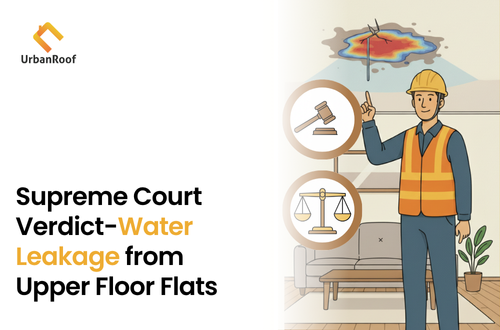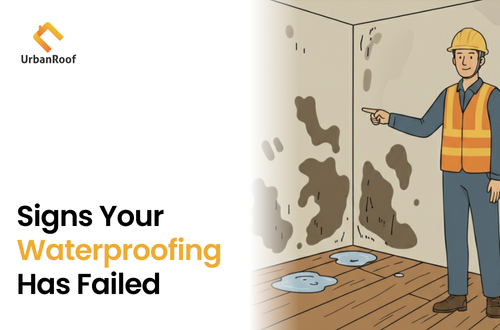Water Leakage from Upper Floor Flats: What the Supreme Court Says – And How Thermography Can Protect You
Discovering water leakage in your home is stressful: damp patches, peeling paint, and damaged ceilings are only the visible signs.
In multi-storey apartment buildings the problem is even more complicated because the source is often an upper-floor bathroom, terrace, or concealed plumbing.
This post explains the legal position, the common causes, and why a scientific inspection (like infrared thermography) is the most effective way to find and fix the root cause.
Several judgments by Indian courts including directions reinforced by the Supreme Court make it clear that responsibility for water leakage depends on the source of the problem.
The legal principles frequently applied are:
- Upper-floor residents are typically responsible for leaks that arise from their internal plumbing or sanitary fittings.
- If the leak originates in a common area (terrace, common drainage, parapet), the society or association may share responsibility.
- If the defect is structural (e.g., poor construction, seepage through RCC), the builder can be held accountable under warranty clauses or RERA, where applicable.
- Court rulings often require the responsible party to compensate for damage to the flat below but you need proof of the leak source and timing.
In practice, these cases turn on evidence: date-stamped images, inspection reports, and demonstrable proof that the leak started from a specific unit or common area.
That’s where a professional report becomes decisive in dispute resolution.
Common Causes of Water Leakage from Upper Floors
Understanding typical failure points helps you avoid bandaid fixes and target the actual problem. Common causes include:
- Faulty bathroom plumbing loose joints, worn gaskets, or cracked drain lines beneath tiles.
- Damaged waterproofing on terraces or balconies that allows rainwater to penetrate the slab.
- Cracked tiles or grout that permit water to trickle into the substrate and slab.
- Blocked or poorly routed drainage that causes overflow and seepage into wall cavities.
- Structural cracks in RCC or parapet walls due to poor concrete compaction or thermal movement.
- Faulty flashing around pipes, chimneys or skylights that no longer seals correctly.
Any of these can produce the visible signs downstairs yellowish stains, paint blistering, damp smell but the actual path of water is often hidden. That’s why visual inspection alone is usually insufficient.
Why a Scientific Diagnosis Matters
Fixing water leakage by chasing visible stains is risky: contractors may remove tiles, replace waterproofing, or re-plaster the ceiling without addressing the real source.
This leads to recurring leaks and wasted money. A scientific diagnosis gives you:
- Clear evidence (thermographic images, moisture maps, written engineer’s report) showing where water is entering the structure.
- Severity classification which components need urgent repair vs. monitoring.
- Repair options with cost and longevity estimates so you can choose the right solution.
- Legal-grade documentation useful for society complaints, builder warranties, or court proceedings.
What Is Infrared Thermography and How It Helps
Infrared thermography is a non-destructive imaging technique that measures temperature variations on surfaces. Moisture-rich areas often show temperature differences compared to dry regions even when the leak is hidden under tiles or plaster.
Typical thermography advantages:
- Detects hidden damp patches and seepage tracks without invasive chipping.
- Creates visual, time-stamped images that map the leak path from the point of entry to visible damage.
- Helps prioritise repairs (stop source first, then remediate damaged finishes).
What You Receive from an Urbanroof Thermographic Inspection
When Urbanroof performs an inspection, typical deliverables include:
- Engineer-led site visit with a safety-first approach.
- High-resolution thermographic images with annotations showing moisture zones.
- Moisture meter readings where needed to quantify dampness levels.
- A clear written report stating root cause, severity (Good / Moderate / Severe), recommended short-term fixes and long-term repairs.
- Cost estimate and timescale for proposed remedial works.
These documents are essential when you need to escalate the matter to your housing society, builder, or legal counsel.
How to Use the Report: Practical Steps
- Share the report with the upper-floor resident and the society’s maintenance committee.
- If the builder is liable (warranty period), send the report to the builder with a formal repair request.
- If the other party contests the findings, the thermographic images and engineer’s conclusions provide strong supporting evidence for mediation or legal action.
- Proceed with repairs that target the source first (plumbing/flashings/waterproofing), then remediate internal finishes.
Preventive Measures to Reduce Water Leakage Risk
- Regularly inspect and service bathroom fittings and concealed plumbing.
- Renew terrace waterproofing every 5–7 years depending on material and climate exposure.
- Keep drainage points and downpipes clear of debris.
- Repair hairline cracks quickly; don’t wait for them to widen.
- Use certified contractors and insist on warranty for waterproofing works.
Treat Water Leakage Seriously Get Proof, Not Promises
Water leakage is both a maintenance and a legal issue. The short-term cost of an accurate, engineer-backed thermographic inspection almost always pays for itself by preventing repeated repairs, saving interiors, and giving you the documentation needed to recover costs from responsible parties.
Urbanroof provides engineer-led thermography and detailed reports tailored for apartment disputes and warranty claims. If you’ve found a stain on the ceiling or suspect hidden seepage, don’t guess get a scientific diagnosis and a clear action plan.




